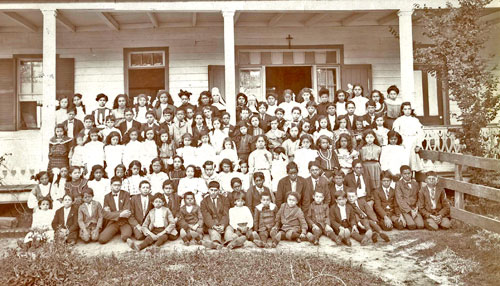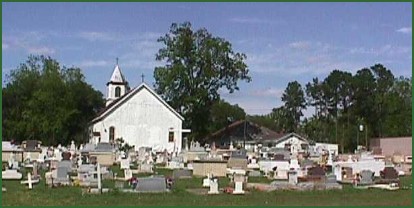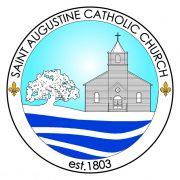History of St. Augustine Catholic Church
"...la portion de terrre ci-apres donnee a mes enfant..Leglise Saint Augustin...batie par moi et ma famille principalement pur notre usage: ... cependant je desire, et telle que les etrangers professant notre sainte religion ctholique, Apostolique et Romaine, ayant le droit d'assister a l'office divin dans la dite chapelle."
"...the parcel of land herein donated to my children...the church of St. Augustine...built by me and my family principally for our usage:...it is my desire that others professing our holy Roman Catholic and apostolic religion, have the right to assist at the divine office in the said chapel."
These words, displayed in the sacristy of St. Augustine Catholic Church, will forever define the roots of the Cane River gens de couleur libre (free people of color) and will mark the are where their European ancestors settled in the French colony of Louisiana over 268 years ago. During this time, twelve generations of descendants and area residents have come to practice their holy Roman Catholic faith and on holy days of obligation.
Since arriving to this country, "our people" as we are not commonly referred to, have assimilated with the various races that occupy this country, but the majority still align themselves with the patriarch of the community and his mother country, France.
The first recorded history of the parish is the blessing of the church by Fr. J. B. Blanc on July 19, 1829 under the title of St. Augustine, the patron saint of Augustin Metoyer. At this time, the church was to be a mission of St. Francois of Natchitoches. However, the written record does not always agree with oral tradition. Tradition has it that Augustin's father, Claude Thomas Pierre Metoyer had taken him to France in 1801 to visit his homeland. While there Augustin was struck by the arrangement of the French villages where community life was centered about the church. Upon his return to the Isle Brevelle and wit the help of his family, the first church was constructed in 1803. While the year the first church was built will probably always remain a mystery, the fact remains that St. Augustine Catholic Church was built by free people of color using their own money, predominately for their own use, and invited all others in the area who wished to participate and share in their Catholic faith with them. As a means of collecting money for the church in earlier times, families of the parish were required to rent pews for their personal use. Name boxes where attached at the end of each pew which allowed its owner exclusive use, even if the church was full.
Although Augustin donated the land for the church, his brother Louis was the architect and builder, with other family members donating religious items. In honor of the two family members primarily responsible for completing the church, two paintings of their patron saints were placed in the church, one of St. Augustine and the other of St. Louis. While the painting of St. Louis was destroyed or lost in the 1960's, the painting of St. Augustine still remains. The bell in the church tower is the only remaining object that was used in the original church and is still in use today summoning parishioners of the area to its doors.
On March 11, 1856, the mission of St. Augustine at Isle Brevelle was decreed by Bishop Auguste Martin to be a parish in in its own right and assigned his own brother, Fr. Francois Martin to be its first resident pastor. As a parish in its own right, St. Augustine expanded to serve four other churches in the area, St. Charles at Bermuda, St. Anne's at Spanish Lake, St. Joseph's at Bayou Derbonne, and St. Anne's on Old River, with the latter maining the only active mission church of the parish to date.
In 1913 under Bishop Van de Van, the order of Holy Ghost Fathers took charge of the parish and remained until 1990. The dedication of the existing church structure by Bishop Van De Van was at a solemn high mass on February 15, 1917 with Fr. J. Baumgartner as its pastor.
On June 1oth 1970, through the intercession of St. Augustine, the patron saint of our Church, our parish was bless with the acquisition of a masterpiece. At an auction on Melrose Plantation, Fr. Norbert Rosso, pastor of St. Augustine Catholic Church, gave a moving speech telling the history of the painting and introduced some of Augustin Metoyer's descendants. He then placed an opening bid of $2,000.00 and after a dead silence and no other offers, the bidding was closed and the painting of Augustin was returned home.
Bishop Sam Jacobs rededicated the church after a restoration and remodeling project that included the addition of a structure adjoining the church and rectory under Fr. Victor Vead on February 25, 2001.

History of St. Joseph School
Formal education at Isle Brevelle preceded the church, as it importance was valued in the colony’s earliest day as it is today. The first French and Spanish immigrants to the Isle saw to it that their children attained the same level of education that they themselves received in Europe. Courthouse records indicate a masterty of the French language, which was used in conducting their business affairs. At one time the gens de couleur libre possessed an equal if not greater education than their surrounding white counterparts.
The first known convent and school building still exists on Cane River, the Badin Roque house. Now an historic landmark because of it poteaux en terre and bousillage construction, it was first opened as a private school in 1857 under the direction of the Daughters of the Cross, a French order of nuns. The first sisters who were assigned to the school were Sr. Mary Agathe, Sr. Mary of Jesus, Sr. Mary Marthe and Sr. St. John the Baptist who was appointed first superior. The sisters chose to name the school after St. Joseph instead of St. Augustine, the patron saint of the parish. Student enrollment rose quickly and the combination school and convent could not serve all the students. It was sold in 1860 to the Badin Roque family and a school and convent were built on the site of the present convent on church property.
After the beginning of the Civil War and subsequent Reconstruction era, the nuns found it difficult to teach the children of Isle Brevelle and closed the school.
In 1887 Bishop Durier of Natchitoches invited the Daughters of the Cross to return, but they declined. He ten invited the Sisters of Divine Providence from San Antonio, Texas and they accepted.
On November 2, 1889 the school re-opened with three pupils and two nuns, Sr. Marie Donate and Sr. Mary Benedict. The numbers steadily increased and by Christmas the attendance was 47. By the end of the school year there were 57 enrolled.
In 1917, the old school was abandoned and Fr. Baumgartner erected a new school. The new school consisted of a large two story frame building and was erected with the assistance of a donation given to the parish by Saint Katherine Drexel, founder of the Sisters of the Blessed Sacrament for Indian and colored missions.
The Sisters of Divine Providence remained at Isle Brevelle and continued to hold classes until May 1967. In that year the school was closed and only CCD classes were held. The nuns have since officially closed the convent and sold the adjoining property.

